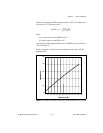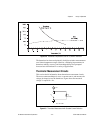Chapter 4 Theory of Operation
SCXI-1503 User Manual 4-10 ni.com
Thermistors
A thermistor is a piece of semiconductor made from metal oxides, pressed
into a small bead, disk, wafer, or other shape, sintered at high temperatures,
and finally coated with epoxy or glass. The resulting device exhibits an
electrical resistance that varies with temperature.
There are two types of thermistors: negative temperature coefficient (NTC)
thermistors, whose resistance decreases with increasing temperature, and
positive temperature coefficient (PTC) thermistors, whose resistance
increases with increasing temperature. NTC thermistors are more
commonly used than PTC thermistors, especially for temperature
measurement applications.
A main advantage of thermistors for temperature measurement is their
extremely high sensitivity. For example, a 2,252 Ω thermistor has a
sensitivity of –100 Ω/°C at room temperature. Higher resistance
thermistors can exhibit temperature coefficients of –10 kΩ/°C or more.
In comparison, a 100 Ω platinum RTD has a sensitivity of only 0.4 Ω/°C.
Also, the physically small size and low thermal mass of a thermistor bead
allows a very fast response to temperature changes.
Another advantage of the thermistor is its relatively high resistance.
Thermistors are available with base resistances (at 25 °C) ranging from
hundreds to millions of ohms. This high resistance diminishes the effect of
inherent resistances in the lead wires, which can cause significant errors
with low resistance devices such as RTDs. For example, while RTD
measurements typically require 3- or 4-wire connections to reduce errors
caused by lead-wire resistances, 2-wire connections to thermistors are
usually adequate.
The major trade-off for the high resistance and sensitivity of the thermistor
is its highly nonlinear output and relatively limited operating range.
Depending on the type of thermistor, the upper range is typically limited to
around 300 °C. Figure 4-4 shows the resistance-temperature curve for a
2,252 Ω thermistor. The curve of a 100 Ω RTD is also shown for
comparison.


















